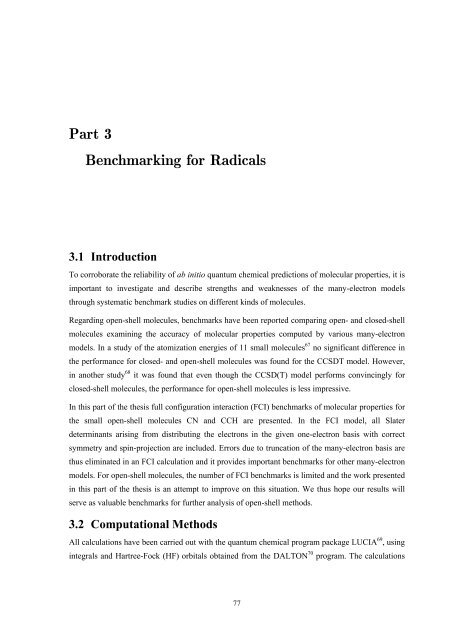Get my PhD Thesis
Get my PhD Thesis
Get my PhD Thesis
Create successful ePaper yourself
Turn your PDF publications into a flip-book with our unique Google optimized e-Paper software.
Part 3<br />
Benchmarking for Radicals<br />
3.1 Introduction<br />
To corroborate the reliability of ab initio quantum chemical predictions of molecular properties, it is<br />
important to investigate and describe strengths and weaknesses of the many-electron models<br />
through systematic benchmark studies on different kinds of molecules.<br />
Regarding open-shell molecules, benchmarks have been reported comparing open- and closed-shell<br />
molecules examining the accuracy of molecular properties computed by various many-electron<br />
models. In a study of the atomization energies of 11 small molecules 67 no significant difference in<br />
the performance for closed- and open-shell molecules was found for the CCSDT model. However,<br />
in another study 68 it was found that even though the CCSD(T) model performs convincingly for<br />
closed-shell molecules, the performance for open-shell molecules is less impressive.<br />
In this part of the thesis full configuration interaction (FCI) benchmarks of molecular properties for<br />
the small open-shell molecules CN and CCH are presented. In the FCI model, all Slater<br />
determinants arising from distributing the electrons in the given one-electron basis with correct<br />
symmetry and spin-projection are included. Errors due to truncation of the many-electron basis are<br />
thus eliminated in an FCI calculation and it provides important benchmarks for other many-electron<br />
models. For open-shell molecules, the number of FCI benchmarks is limited and the work presented<br />
in this part of the thesis is an attempt to improve on this situation. We thus hope our results will<br />
serve as valuable benchmarks for further analysis of open-shell methods.<br />
3.2 Computational Methods<br />
All calculations have been carried out with the quantum chemical program package LUCIA 69 , using<br />
integrals and Hartree-Fock (HF) orbitals obtained from the DALTON 70 program. The calculations<br />
77

















